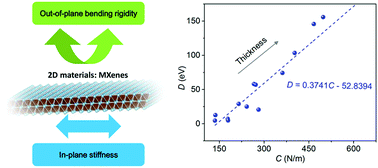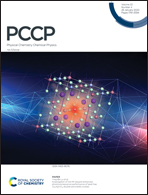Quantifying the rigidity of 2D carbides (MXenes)†
Abstract
MXenes represent a family of surface-functionalized two-dimensional (2D) carbides and nitrides with potential applications in the field of flexible electronics, which rely on their elasticity and flexibility. However, the knowledge on such aspects is rather limited. Here, taking the four most typical MXenes, namely, Ti2CTx, Ti3C2Tx, Nb2CTx and Nb4C3Tx (T = O, OH and F) as examples, we evaluate their intrinsic in-plane stiffness and out-of-plane rigidity at the nanoscale with respect to their functional groups, chemical components and thickness by first-principles calculations. We find that both the in-plane stiffness (C) and out-of-plane bending rigidity (D) of MXenes are highly dependent on the thickness of MX and the surface functional groups. Specifically, the thickness and surface functionalization increase C and D significantly. The Foppl-von Karman numbers per area (C/D), as the flexibility descriptor, of MXenes are comparable with that of the MoS2 monolayer, indicating MXenes as a class of strong yet bendable materials. The effective thickness, the critical parameter bridging C and D, of MXenes is determined to be only two-thirds of the average layer spacing. This study provides a fundamental basis for quantifying the rigidity of MXenes at the nanoscale.



 Please wait while we load your content...
Please wait while we load your content...